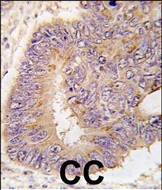PDE8A Antibody (Center) (L572)
Purified Rabbit Polyclonal Antibody (Pab)
- SPECIFICATION
- CITATIONS
- PROTOCOLS
- BACKGROUND

Application
| IHC-P, WB, E |
|---|---|
| Primary Accession | O60658 |
| Reactivity | Human |
| Host | Rabbit |
| Clonality | Polyclonal |
| Isotype | Rabbit IgG |
| Calculated MW | 93304 Da |
| Antigen Region | 557-587 aa |
| Gene ID | 5151 |
|---|---|
| Other Names | High affinity cAMP-specific and IBMX-insensitive 3', 5'-cyclic phosphodiesterase 8A, PDE8A |
| Target/Specificity | This PDE8A antibody is generated from rabbits immunized with a KLH conjugated synthetic peptide between 557-587 amino acids from the Central region of human PDE8A. |
| Dilution | IHC-P~~1:50 WB~~1:1000 E~~Use at an assay dependent concentration. |
| Format | Purified polyclonal antibody supplied in PBS with 0.09% (W/V) sodium azide. This antibody is prepared by Saturated Ammonium Sulfate (SAS) precipitation followed by dialysis against PBS. |
| Storage | Maintain refrigerated at 2-8°C for up to 2 weeks. For long term storage store at -20°C in small aliquots to prevent freeze-thaw cycles. |
| Precautions | PDE8A Antibody (Center) (L572) is for research use only and not for use in diagnostic or therapeutic procedures. |
| Name | PDE8A |
|---|---|
| Function | Hydrolyzes the second messenger cAMP, which is a key regulator of many important physiological processes (PubMed:18983167). May be involved in maintaining basal levels of the cyclic nucleotide and/or in the cAMP regulation of germ cell development (PubMed:18983167). Binding to RAF1 reduces RAF1 'Ser-259' inhibitory- phosphorylation and stimulates RAF1-dependent EGF-activated ERK- signaling (PubMed:23509299). Protects against cell death induced by hydrogen peroxide and staurosporine (PubMed:23509299). |
| Tissue Location | Expressed in most tissues except thymus and peripheral blood leukocytes. Highest levels in testis, ovary, small intestine and colon |

Thousands of laboratories across the world have published research that depended on the performance of antibodies from Abcepta to advance their research. Check out links to articles that cite our products in major peer-reviewed journals, organized by research category.
info@abcepta.com, and receive a free "I Love Antibodies" mug.
Provided below are standard protocols that you may find useful for product applications.
Background
PDE8A plays a role in signal transduction by regulating the intracellular concentration of cyclic nucleotides. This phosphodiesterase, which has a high affinity for cAMP, may be involved in maintaining basal levels of the cyclic nucleotide and/or in the cAMP regulation of germ cell development.
References
Wu,P., Proc. Natl. Acad. Sci. U.S.A. 101 (51), 17634-17639 (2004)
Gamanuma,M., Cell. Signal. 15 (6), 565-574 (2003)
If you have used an Abcepta product and would like to share how it has performed, please click on the "Submit Review" button and provide the requested information. Our staff will examine and post your review and contact you if needed.
If you have any additional inquiries please email technical services at tech@abcepta.com.













 Foundational characteristics of cancer include proliferation, angiogenesis, migration, evasion of apoptosis, and cellular immortality. Find key markers for these cellular processes and antibodies to detect them.
Foundational characteristics of cancer include proliferation, angiogenesis, migration, evasion of apoptosis, and cellular immortality. Find key markers for these cellular processes and antibodies to detect them. The SUMOplot™ Analysis Program predicts and scores sumoylation sites in your protein. SUMOylation is a post-translational modification involved in various cellular processes, such as nuclear-cytosolic transport, transcriptional regulation, apoptosis, protein stability, response to stress, and progression through the cell cycle.
The SUMOplot™ Analysis Program predicts and scores sumoylation sites in your protein. SUMOylation is a post-translational modification involved in various cellular processes, such as nuclear-cytosolic transport, transcriptional regulation, apoptosis, protein stability, response to stress, and progression through the cell cycle. The Autophagy Receptor Motif Plotter predicts and scores autophagy receptor binding sites in your protein. Identifying proteins connected to this pathway is critical to understanding the role of autophagy in physiological as well as pathological processes such as development, differentiation, neurodegenerative diseases, stress, infection, and cancer.
The Autophagy Receptor Motif Plotter predicts and scores autophagy receptor binding sites in your protein. Identifying proteins connected to this pathway is critical to understanding the role of autophagy in physiological as well as pathological processes such as development, differentiation, neurodegenerative diseases, stress, infection, and cancer.



